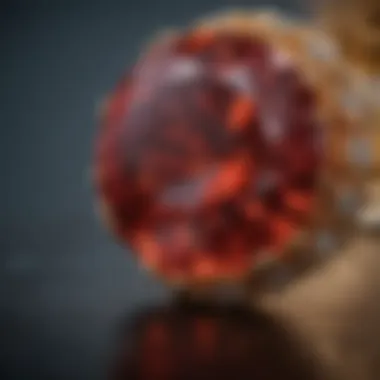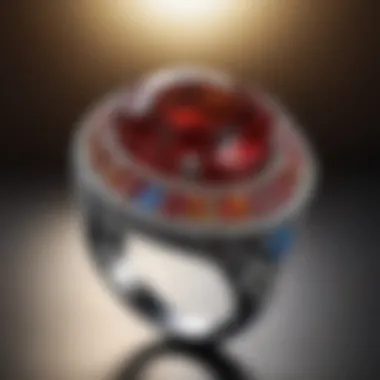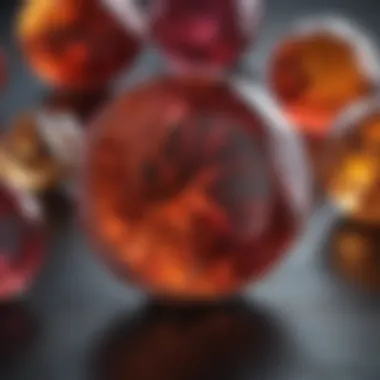The Birthstone of January 26th: Its Rich Significance


Intro
Every January, as the chill of winter settles in, something remarkable emerges from the depths of the Earth. Those born on the 26th of this month have a connection to a special gemstone often referred to as the birthstone of January. This remarkable mineral isn't just a pretty face; it carries a wealth of significance, steeped in history, tradition, and mystical beliefs. Understanding this birthstone reveals not just its physical beauty, but also its role in culture and personal identity.
In this exploration, we will travel back to its origins, uncover its unique properties, and examine its importance in jewelry making and holistic practices. The journey through the facets of this gem promises to enlighten, resonating with both gemstone enthusiasts and a wider audience eager to uncover the layers of meaning encapsulated in this unique stone.
Gemstone Overview
Description of the gemstone
The birthstone for those born on January 26th is garnet. This gemstone shines as a popular choice for gemstone collectors and jewelry designers alike. With shades that range from deep reds to vibrant greens, garnet is indeed a feast for the eyes. Some varieties even show striking color changes when exposed to different lighting.
This mineral, primarily composed of aluminum and iron, finds its richest hues in chromium and manganese, making gemstones with these elements particularly desirable. Often, garnets are faceted to highlight their brilliance and clarity, adding an extra layer of allure.
Physical properties
Garnet isn't just beautiful; it possesses remarkable physical properties too. With a hardness scale rating of 6.5 to 7.5, it stands fairly resilient against scratches and damage. Moreover, it exhibits an isometric crystal system, which speaks to its symmetrical beauty in crystal form. This makes garnet a reliable choice not just in jewelry but in industrial applications as well.
Its transparency can range from translucent to completely clear, with the most prized varieties tending towards the latter.
"Garnet is not just a gem; it's a story of geological history captured in time."
Healing Properties
Metaphysical attributes
Like many gemstones, garnet is often attributed various metaphysical properties. It's commonly believed to boost energy and vitality, making it a popular choice for individuals seeking to enhance their physical strength. Many feel that garnet can inspire passion and restore lost motivation, acting as a tether to the emotional self.
It's not uncommon to hear anecdotes of garnet enhancing self-confidence and courage, supporting wearers in their struggles or emotional battles.
Common uses in holistic practices
In holistic practices, garnet is often employed for its purported healing qualities. Many holistic practitioners suggest using garnet during meditation to encourage deeper states of awareness and emotional healing.
Some even make use of garnet in crystal grids designed to promote stability and grounding:
- Stress relief: Placing garnet in one's environment may ease tension, as many believe it absorbs negative energy.
- Emotional balance: Routine contact with garnet is said to align the wearer's emotions, fostering a sense of tranquility.
- Fostering love: Garnet is often dubbed a stone of love and commitment, believed to strengthen existing relationships and bridge emotional gaps.
By exploring the compelling attributes tied to garnet, individuals can find a deeper connection not only to the stone itself but to the aspects it represents in their lives.
Prelude to January Birthstones
January birthstones carry a weight of significance that transcends mere aesthetics. With the arrival of the new year, those celebrating birthdays in January find themselves affiliated with a stone that has captivated human beings for centuries. In this article, we will explore why these birthstones matter on multiple levels: emotional, historical, and practical.
Understanding the importance of January's birthstones begins with recognizing their unique properties and symbolic meanings. Garnet is often considered the primary birthstone for January, but there's more to the story, as the stone comes in various types and colors, each with its own significance.
Aside from their aesthetic appeal, these gemstones are believed to possess healing and protective qualities. The metaphysical properties attached to garnet, for example, invite wearers to connect with their internal strength while fostering a sense of passion and groundedness.
Across various cultures and periods, these birthstones have found a place in jewelry, rituals, and even medicinal practices. By delving into the historical context of birthstones, we can appreciate their journey through time and how they've been utilized in different spheres of life.
Ultimately, the exploration of January birthstones, particularly garnet, offers an insightful perspective on how a seemingly simple mineral encapsulates a tapestry of human experience. Let's get into the details by first laying out an overview of what makes January's birthstones so special.
Overview of January Birthstones
January features two primary birthstones: garnet and a less common choice, the emerald. However, garnet takes center stage. It’s most recognizable in its rich red hue, but variations abound, allowing for a broader palette that appeals to diverse tastes.
Why Focus on Garnet?
- Historical Significance: Its use spans ancient civilizations, from the Egyptians to the Romans.
- Symbolic Associations: Representing love, friendship, and loyalty, garnet has timeless reputations.
- Metaphysical Fascinations: Many believe it to be a stone of health and protection.
Garnet can be found not only in jewelry but also in textiles, where it was historically ground down to create dyes. Thus, its practical applications go beyond aesthetics into the realm of utility.
Overall, whether viewed through the lens of personal identity, historical relevance, or cultural narratives, January birthstones unfold a complex and enriching storyline.
Historical Context of Birthstones


The history of birthstones is as colorful as the stones themselves, filled with traditions and meanings that shift over time and across societies. The concept of birthstones likely originated from biblical texts, where the twelve stones of Aaron’s breastplate corresponded to the twelve tribes of Israel. This connection to identity has persisted, evolving into modern birthstone practices that attribute different meanings and characteristics to each month.
"Throughout history, people have worn gemstones not just for beauty, but for their believed powers and properties."
Garnet found its place in various cultures, widely recognized in Europe during the Middle Ages. Believed to bring protection during travels, it became a popular gift among travelers hoping to ensure safe journeys.
In Egypt, garnet traded handily, often buried with pharaohs as a means of protection in the afterlife, a practice echoing through the ages. Meanwhile, the association with healing has been reiterated across cultures, affecting the way people choose their jewelry today. Individuals are now keenly aware of their stones, investing not only in appearance but also in emotional resonance.
By exploring the historical context of birthstones, we gain insight into how they shape contemporary practices and beliefs surrounding personal identity and connection.
Primary Birthstone for January 26th
The primary birthstone for January 26th is garnet, a gemstone that carries a profound significance both historically and in contemporary jewelry. Garnet is often associated with resilience and loyalty, making it an ideal symbol for those born in January. Its rich red hues, which can vary from light to dark, evoke feelings of warmth and passion. This section aims to highlight the unique attributes of garnet and the relevance it holds not just as a gemstone, but also within cultural and personal contexts.
Garnet: The Stone of January
Garnet has been treasured for centuries, not merely for its beauty but for its perceived powers. It has often functioned as a talisman, protecting travelers and inspiring confidence. Many cultures esteem garnet for its connection to the heart and blood, symbolizing life and vitality. Within the realm of gemstone enthusiasts, the garnet's ability to spark conversation makes it a notable piece in any collection.
As a stone that is both captivating and meaningful, garnet showcases a depth that invites exploration. For those adorned with this stone, it carries a sense of identity that resonates deeply.
Variations of Garnet
The magnificent diversity of garnet comes in various colors and types, elevating it beyond mere decoration to a focus of study for gemologists and collectors alike.
Garnet Colors and Types
Garnet is not a one-note wonder; it features a myriad of colors and types. The most renowned among these is the deep red almandine garnet, often seen in classic settings. However, garnet also comes in shades of green, orange, and even purple, with tsavorite and spessartite garnets being prime examples. This variety is not just a feast for the eyes, but it also offers options that can be tailored to different preferences, occasions, and styles.
A particularly interesting feature is how garnet's color can shift based on its lighting conditions, providing a gem with layers of personality. This characteristic makes garnet a recommended choice for anyone looking to express themselves through their jewelry. The benefits include an extensive selection that caters to various tastes, although the varying types may require a keen eye to discern quality.
Garnet's Geographical Sources
The geographical origins of garnet add another layer of depth to its significance. This gemstone is found in various locations around the globe, from the lush landscapes of Africa to the rugged terrains of India and the United States. Each region contributes its unique flavor to the garnet market.
For instance, the garnets from Namibia are celebrated for their vibrant colors and clarity, while those from Brazil often have a more muted palette but are prized for their consistency.
This geographic diversity not only ensures a broad range of aesthetic options but also raises questions about sourcing practices. Awareness of where a garnet comes from can be an important factor for ethical collectors. It's worth noting that while certain regions may produce higher-quality stones, challenges such as environmental impact or labor practices are worth considering when purchasing garnets.
In summation, the primary birthstone for January 26th—garnet—offers a kaleidoscope of colors and origins, embodying both beauty and complexity. As we continue to explore garnet's attributes, its significance as a cherished stone across cultures and times only intensifies, making it a gem worth celebrating.
The Chemical and Physical Properties of Garnet
Understanding the chemical and physical properties of garnet not only allows gemstone enthusiasts to appreciate its beauty on a surface level but also sheds light on its durability and versatility in various applications. These properties are pivotal as they underpin garnet's appeal in both the worlds of jewelry design and geology. By delving deeper, we can grasp the elements that make garnet a stone cherished through time.
Chemical Composition
Garnet is a complex silicate mineral that comprises several components varying in type and amount. It is primarily recognized for its distinct crystalline structure, made up of aluminum, iron, magnesium, and silica. However, garnet isn't just one single mineral; it's a group of related minerals. This diverse composition allows for the existence of various garnet types, each with unique colors and properties. The common varieties include pyrope, almandine, spessartine, grossular, and andradite, each contributing to the range of colors typically associated with garnets.
Garnets usually form in high-temperature and high-pressure environments, typically in metamorphic rocks. The chemical diversity can influence factors like hardness and brilliance, making it essential to know these details for applications such as jewelry. The wide-ranging compositions also explain why garnets can be found in shades from deep red to vibrant green.
Formation and Occurrence
Garnet crystals are primarily formed in metamorphic rocks, created through processes involving high temperatures and pressures typically found deep within the earth. These conditions can occur in regions affected by tectonic plate activity. Garnet can also form in igneous rocks and even some sedimentary deposits, but the metamorphic origin remains the most predominant.
The geographical distribution of garnets is also fascinating, with significant deposits found in places like Madagascar, the United States, India, and Sri Lanka. Knowing where to find these stones can be beneficial for collectors looking to source high-quality garnets or for designers wishing to incorporate specific types into their work. The natural environment in which garnets appear influences their distinct characteristics and, thus, their appeal to gemstone lovers.
Physical Characteristics
Hardness and Durability
The hardness of garnet plays a significant role in its desirability as a gemstone. Rated between 6.5 and 7.5 on the Mohs scale, garnet exhibits commendable resistance to scratches and general wear. This makes it an excellent choice for pieces intended for everyday wear, such as rings and bracelets. Its durability contributes to its popularity, especially for items that are subjected to daily exposure.
Additionally, garnet's resilience against heat and chemicals means it can maintain its luster and not falter easily under various conditions. Such strengths make garnet a reliable option for both jewelry designers and consumers. Just imagine a beautifully crafted garnet ring cherished for years—it can withstand the test of time while retaining its brilliance.
Clarity and Cut
When it comes to clarity, garnets typically display a remarkable ability to hit high clarity levels, which is primarily due to their crystalline composition. Unlike some other gemstones, garnets often appear free from visible inclusions, leading to a clean, eye-catching appearance. This clarity makes them versatile for various cuts and settings, broadening their appeal among jewelers and customers alike.


The cut of garnet is equally important, as it influences how light interacts with the stone. A well-cut garnet can sparkle and shine, enhancing its natural color and luster. Skilled craftsmanship can highlight the unique characteristics of each garnet type. However, it's worth noting that while garnets perform well in creating beautiful pieces, uneven cuts can detract from their overall brilliance.
"Garnet offers both aesthetic appeal and considerable durability, making it an enduring choice for those who appreciate both natural beauty and practical function in jewelry design."
In summary, the chemical and physical properties of garnet form the foundation of its significance as a gemstone. From its varied chemical composition to its commendable hardness, clarity, and cut, garnet stands out in the world of gemstones. Understanding these attributes enriches the connection between individuals and their garnet jewelry, infusing meaning behind each piece.
Metaphysical Properties of Garnet
The metaphysical properties of garnet are deeply intertwined with its historical and cultural significance. Often celebrated as a stone of passion and energy, garnet is believed to possess various qualities that extend beyond its physical characteristics. For many gemstone enthusiasts, understanding these aspects adds layers of appreciation and meaning to this beautiful stone.
Healing and Protective Qualities
Garnet is widely regarded for its purported healing properties. It’s said to enhance the body’s energy levels, promoting vitality and stamina. People often turn to garnet not just for its aesthetic appeal but also for its ability to cleanse and energize one’s surroundings. Some practitioners in alternative healing circles believe that it helps in establishing emotional balance and grounding, making it a popular choice for meditation practices.
These healing qualities can also extend to a protective nature. In many traditions, garnets are thought to shield their wearer from negative energies and emotional turmoil. It’s this special feature that makes them a sought-out stone during challenging times, offering comfort and support—a real rock in a storm, so to speak.
Symbolism in Different Cultures
The symbolism associated with garnet varies significantly across different cultures, showcasing its diverse roles and meanings throughout history.
Ancient Beliefs and Practices
In ancient cultures, garnet was often seen as a source of strength and protection. For instance, Egyptian pharaohs sometimes adorned themselves with garnets, believing they had the power to connect them with the divine. The unique characteristic of garnet’s vibrant red hue was interpreted by many as a representation of life, love, and combat prowess.
This view held considerable influence in the crafting of amulets and talismans, embedding the stone with symbolic power that many believed could help them in their pursuits, whether in war or in love. Such ancient practices reinforce the belief in garnet's ability to guide and protect, making it a topic of ongoing interest in contemporary discussion around birthstones.
Modern Interpretations
In today’s world, garnet has evolved in its symbolism. Modern interpretations often revolve around self-empowerment and transformation. The stone is associated with igniting the fire within, stimulating desire, and fostering a sense of personal achievement. This shift reflects a broader cultural movement towards self-awareness and emotional intelligence.
It’s often used in settings that encourage personal growth, with many individuals regarding garnet as a catalyst for change. The unique contemporary fascination lies in garnet’s ability to bridge the gap between ancient beliefs and modern practices, making it a relevant choice for individuals seeking a connection to both history and personal enlightenment. This multifaceted nature certainly adds to the stone's allure in the realm of gemstone enthusiasts and collectors.
"Garnet not only dazzles with its brilliance; it weaves a rich tapestry of beliefs that resonate through time, touching individuals far beyond mere adornment."
Understanding garnet's metaphysical properties enriches the overall narrative of this birthstone, providing insights into its captivating past and continuing relevance in the present.
Utilization in Jewelry Design
The integration of garnet into jewelry design brings with it a wealth of significance and aesthetic appeal. As one of the primary birthstones for January, garnet not only captures the eye but also embodies a range of meanings and styles that resonate with wearers. This section will delve into the contemporary roles garnet plays in jewelry, highlighting how its unique properties enhance its value and appeal.
Garnet in Contemporary Jewelry
Garnet has carved its place within the modern jewelry landscape, being favored by designers for its versatility and rich history. Its deep red hues are often associated with love and passion, making it a sought-after choice for engagement rings and special occasions. In contemporary settings, garnet is frequently complemented by various metals, such as gold and silver, which enhance its vibrant color and add to its allure.
Moreover, designers often explore unique cuts and settings, creating pieces that not only showcase the garnet itself but also tell a story. From vintage-inspired lockets to minimalist pendants, garnet jewelry can cater to a wide range of tastes and styles, ensuring there is something for everyone. The adaptability of garnet makes it an evergreen choice in the world of fashion jewelry.
Ethical Sourcing and Considerations
In today's conscientious consumer landscape, ethical sourcing of garnet is a pivotal issue for both consumers and jewelers. As awareness of the mining practices affecting gemstones rises, buyers are increasingly discerning about where their jewelry comes from. Ethically mined garnets, particularly those sourced from reputable suppliers, not only assure the quality of the stone but also support sustainable practices that benefit local communities.
A big part of this discussion involves traceability; consumers want to know the journey of their garnet, from the mine to their hands. Jewelers that can document the sourcing of their materials often find a stronger market presence and loyal customers. This commitment to ethical sourcing reinforces the significance of garnet, making it not just a beautiful stone, but also a responsibly chosen one.
Styling Suggestions for Garnet Jewelry
Garnet's versatility extends beyond its physical attributes, influencing how it can be styled and worn. This section will provide practical suggestions on how to incorporate garnet into various fashion statements.
Pairing with Other Gemstones
Pairing garnet with other gemstones can elevate any jewelry piece—it's like creating a symphony of colors. For example, when garnet is set alongside diamonds or white sapphires, it creates a striking contrast that catches the eye. The brilliance of diamonds enhances garnet's deep hues, resulting in a luxurious appearance.
Moreover, combinations like garnet and amethyst lend an unexpected playfulness to jewelry designs, showcasing both vibrancy and depth.
The unique feature of pairing garnet with other gemstones is the diverse emotional vibrations they can represent together. Each gemstone brings its own characteristics, creating an array of meanings that can speak volumes. While this approach is popular among designers, it's essential to consider color balance and thematic harmony in the overall piece.
Occasions for Wearing Garnets
Garnets are often deemed suitable for numerous occasions, reflecting various sentiments and styles. Their association with passion and energy makes them perfect for romantic gatherings, anniversaries, or even weddings. A garnet ring or a pair of earrings can make a statement during a candlelit dinner, effortlessly showcasing both elegance and emotion.


Additionally, garnets can serve as thoughtful gifts; they symbolize strong bonds and can be worn to celebrate friendships or personal accomplishments. With their rich color, garnets also fit well into casual settings, making them easy to wear daily without sacrificing style.
Caring for Your Garnet Jewelry
Taking care of your garnet jewelry is essential not only for maintaining its beauty but also for ensuring its longevity. Garnet, while sturdy, can still be susceptible to scratches and damage if not treated with care. Understanding how to properly clean and store your garnet pieces can make all the difference in preserving their brilliance and charm.
Cleaning Techniques
When it comes to cleaning garnet jewelry, the method you choose plays a vital role. Here are some effective ways to keep your garnets sparkling:
- Warm Soapy Water: The simplest and safest way to clean garnet jewelry is using warm, soapy water. Mix a mild dish soap with warm water, then soak your item for a few minutes. Use a soft brush, like a toothbrush, to gently scrub any dirt or grime from settings and crevices.
- Avoid Harsh Chemicals: Always steer clear of harsh cleaning agents or ultrasonic cleaners. Chemicals can damage the surface of the garnet and affect its luster.
- Rinse Thoroughly: After scrubbing, make sure to rinse the jewelry well under lukewarm water to remove all soap residues. Any leftover soap can dull the natural shine of the stone.
- Dry with Care: Pat the jewelry dry with a soft cloth instead of rubbing it. This avoids scratches while keeping the stone's surface smooth.
"Proper care begins with understanding that a little bit of effort goes a long way in preserving the beauty of your garnet jewelry."
Storage Recommendations
Storing your garnet pieces properly is just as crucial as cleaning them. Gems require a gentle touch and safe environments. Here are some tips for effective storage:
- Separate from Other Jewelry: Garnets, although durable, can still scratch other softer gemstones. Store them individually or within soft pouches to prevent contact with other jewels.
- Avoid Direct Sunlight: When placing your garnet jewelry in storage, select a cool, dry area away from direct sunlight. Prolonged exposure can lead to fading or damage.
- Regular Checks: Make it a habit to periodically check your garnet jewelry for loose settings or any signs of wear and tear. Early detection can save you a headache and ensure the piece remains intact.
- Use a Jewelry Box: Invest in a quality jewelry box with protective dividers. This helps maintain order and reduces the risk of damage from tangling or crushing with other pieces.
With some basic care guidelines and a mindful approach to cleaning and storage, your garnet jewelry can continue to dazzle and captivate for years to come. Remember, a little diligence goes a long way in protecting and showcasing the unique properties of garnet.
Garnet and Personal Identity
When we ponder the intersections of gemstones and who we are, garnet often comes to the fore—especially for those born in January. It's more than just a pretty stone; the garnet embodies attributes that resonate deeply with personal identity. For many, this vibrant red gem serves as a symbol of qualities like fervor and resilience, compelling individuals to embrace traits that align with this remarkable mineral.
Traits Associated with January Birthdays
People born on January 26th are often characterized as determined and ambitious. They typically show a strong will and a desire to achieve their goals. January natives often approach challenges head-on, powered by an innate drive to succeed. This unyielding will aligns closely with the qualities associated with garnets, creating a natural connection between individuals born in this month and their birthstone.
The following traits are often attributed to January-born individuals:
- Ambition: A relentless pursuit of goals.
- Strong-willed: Not easily swayed by others.
- Passionate: Engaging with life fervently and wholeheartedly.
- Resilient: Able to bounce back from setbacks and challenges.
How Garnet Reflects Personality
Confidence and Passion
Delving into the aspect of confidence and passion, garnet acts as a physical emblem of these characteristics. Confidence is a vital trait for navigating the complex world, and garnet’s rich hue mirrors the way confidence stands out in social settings. Those with January birthdays often find that garnet resonates with their vibrant energy, nudging them to express themselves more boldly.
The relationship between garnet and confidence is particularly beneficial. It encourages individuals to embrace their inner warrior, pushing them to overcome self-doubt and engage fully in their aspirations.
One unique feature of confidence as reflected by garnet is its power to evoke courage. This attribute can lead individuals to seize opportunities that might otherwise be daunting. Leveraging this stone can also enable them to manifest their dreams into reality, which is a compelling benefit of incorporating garnet into one’s life.
Groundedness and Security
On the other hand, groundedness and security are essential aspects that garnet promotes. This stone is seen as a grounding force, anchoring those who carry or wear it, both literally and metaphorically. Groundedness allows January-born individuals to stay connected to their core values, making it a crucial element in personal identity.
The association between garnet and groundedness translates into emotional stability and security. For those who may feel lost or confused, garnet can serve as a reminder to stand firm and aware of their identities. This stone provides a sense of safety, allowing individuals to explore their depths without fear.
In essence, the unique feature of security that garnet offers connects to a broader understanding of our place in the world. It promotes self-acceptance, ensuring that those born in January can embrace who they are, with all their complexities. Imagine wearing a garnet pendant, serving as a talisman that whispers, "You are secure within yourself."
The deeper we dive into the characteristics garnet embodies, the clearer it becomes that this stone is more than an accessory; it is a beacon of identity, illuminating the paths of self-discovery and personal growth.
Closure
The significance of garnet, as the primary birthstone for January 26th, extends beyond its aesthetic appeal. This article has meticulously examined the properties, uses, and cultural associations of garnet, furnishing a rich overview of both its heritage and its place in modern society. With its vibrant colors and depth, garnet not only adorns various jewelry pieces but also embodies meaningful qualities that can be aligned with the identities of those born in January.
Recap of Garnet's Importance
To recap, garnet is not just a beautiful gemstone; it represents qualities such as confidence and passion. Historically, it has been worn as a protective talisman, believed to shield the wearer from negativity and bring forth peace of mind. Garnet’s unique properties—from its striking array of colors to its remarkable durability—make it a favored choice among enthusiasts and collectors alike.
- Historically Significant: Garnet's use spans across different cultures, frequently symbolizing love and loyalty.
- Diverse in Variability: There are multiple varieties of garnet, each with its own unique charm.
- Practical Benefits: Aside from its beauty, garnet serves practical uses in various industries due to its hardness.
"Garnet is more than a gemstone; it's a story wrapped in layers of color and culture, reflecting the very essence of those who wear it."
Encouragement for Further Exploration
For those who are intrigued by the lore and allure of garnet, the journey doesn't have to end here. Consider delving deeper into its many folklore tales that span continents. Learning about the gem's place in different cultures provides context and depth, revealing how it has been revered and incorporated into rituals and traditions.
Venturing beyond just garnet, one can explore other birthstones and their meanings. Understanding the broader family of gemstones enriches one's appreciation for natural beauty and its connection to human experience. Engaging with communities, both online and off, can lead to insightful discussions, enabling you to grow your knowledge and perhaps even participate in gemstone collecting.
Discover resources such as Wikipedia for foundational knowledge, or visit gemstone forums on platforms like Reddit to exchange tips and experiences with fellow enthusiasts.







